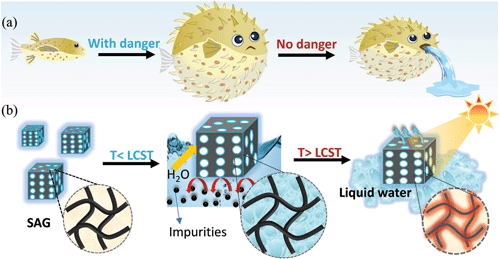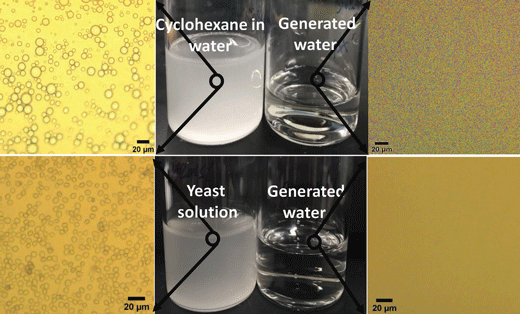| Apr 13, 2021 | |
Pufferfish inspires solar-driven water purification |
|
| (Nanowerk Spotlight) The application areas for nanotechnology in water applications are manifold and include treatment and remediation; sensing and detection; and pollution prevention. | |
| Only 30% of all freshwater on the planet is not locked up in ice caps or glaciers (not for much longer, though...). Of that, some 20% is in areas too remote for humans to access and of the remaining 80% about three-quarters comes at the wrong time and place – in monsoons and floods – and is not always captured for use by people. The remainder is less than 0.08 of 1% of the total water on the planet. | |
| The demand for these scarce water resources is growing even faster than that for energy. Currently, it is estimated that more than 2 billion people face water scarcity. The WHO estimates that by 2025, half of the world's population will be living in water-stressed areas. | |
| "A solution to the water scarcity problem must be environmentally benign and not result in further strain on clean water availability," Rodney D. Priestley, the Betty Perry Smith Professor of Chemical and Biological Engineering at Princeton University, tells Nanowerk. "Although solar-driven water evaporation using sunlight is a promising sustainable strategy, the water production rate via solar technologies remains insufficient to meet practical demands." | |
| Addressing this issue, Priestley's group has developed a solar absorber gel (SAG) to purify water from contaminated sources using only natural sunlight. | |
| The team reports their findings in Advanced Materials ("A Bioinspired Elastic Hydrogel for Solar-Driven Water Purification"). | |
| "Our solar absorber gel can force liquid water out of the gel via phase transition when the sun warms the material, so the water purification mechanism does not require water evaporation," explains Dr. Xiaohui Xu, a Presidential Postdoctoral Research Fellow in Priestley's group, and first author of the paper. | |
| The researchers' material design approach was inspired by the absorption and release cycle of water by the pufferfish: it can inflate itself by intaking water when threatened and release it to return to its original shape when the threat of danger disappears. | |
 |
|
| Sunlight-driven SAG technology for water production. a) The shape change of a pufferfish via the uptake and release of water when threatened. b) Inspired by the pufferfish, the SAG technology is based on the phase transformation (swelling and de-swelling) of PNIPAm under natural sunlight. SAG harvests large quantities of clean water from contaminated water at atmospheric temperature and generates clean water under natural sunlight. (Reprinted with permission by Wiley-VCH Verlag ) (click on image to enlarge) | |
| The team's process exploits soft-matter phase transformations that only need solar energy to work. Under sunlight irradiation, due to the hydrogel phase transformation from the swollen hydrophilic state to the collapsed hydrophobic state, clean liquid water, is expelled from SAG. | |
| "Our multi-modal mechanism of pure water production under natural sunlight opens a new paradigm for high-rate, clean water production from contaminated water sources using renewable solar energy," Xu point out. | |
| To enable hydrogels to harvest solar energy, they must be modified with an efficient solar absorber. | |
| Xu explains: "To modify hydrogels, we used polydopamine, a melanin-based polymer that exhibits broadband solar absorption and noble photothermal conversion efficiency. PDA offers additional properties of benefit for water purification: the presence of amino groups and aromatic rings endow PDA with the ability to remove heavy metal ions and organic dyes through chelation and hydrogen bonding." | |
| To fabricate their solar absorber gel, the team deposited PDA and cross-linked sodium alginate (this layer improves salt rejection of the gel) atop a macroporous PNIPAm (poly(N-isopropyl acrylamide) hydrogel. | |
| The operation of this technology is simple: upon immersion into contaminated water, the solar absorber gel absorbs large quantities of clean water while salts, biologics, oils, and other pollutants are repelled. | |
| Once exposed to natural sunlight, solar absorption by the PDA thermally heats the gel above the lower critical solution temperature of PNIPAm (the required temperature is above 34 °C). Due to the hydrogel phase transformation from the swollen hydrophilic state to the collapsed hydrophobic state at this temperature, clean liquid water, as liquid and vapor, is expelled from the gel. | |
 |
|
| Digital and microscopy photographs of SDS-stabilized cyclohexane-in-water emulsion (top) and yeast solution (bottom) before and after treatment with SAG. (Reprinted with permission by Wiley-VCH Verlag ) | |
| Since the purification mechanism does not require water evaporation (in the team's experiments, the purified water temperature was ∼30 °C), an energy-intensive process, the water collection rate is higher than those that do rely on evaporation and, according to the team, the highest reported for any passive solar water-purification system. | |
| "With a water purification rate of 7.18 kg m-2 h-1 under sunlight, the development of SAG should be of interest to both industry and governments that are concerned with improving access to clean water in a sustainable, low-energy approach to the world's population," Priestley concludes. "The technology is both scalable and modular and may be used to purify water from various sources." | |
 By
Michael
Berger
– Michael is author of three books by the Royal Society of Chemistry:
Nano-Society: Pushing the Boundaries of Technology,
Nanotechnology: The Future is Tiny, and
Nanoengineering: The Skills and Tools Making Technology Invisible
Copyright ©
Nanowerk LLC
By
Michael
Berger
– Michael is author of three books by the Royal Society of Chemistry:
Nano-Society: Pushing the Boundaries of Technology,
Nanotechnology: The Future is Tiny, and
Nanoengineering: The Skills and Tools Making Technology Invisible
Copyright ©
Nanowerk LLC
|
|
|
Become a Spotlight guest author! Join our large and growing group of guest contributors. Have you just published a scientific paper or have other exciting developments to share with the nanotechnology community? Here is how to publish on nanowerk.com. |
|
